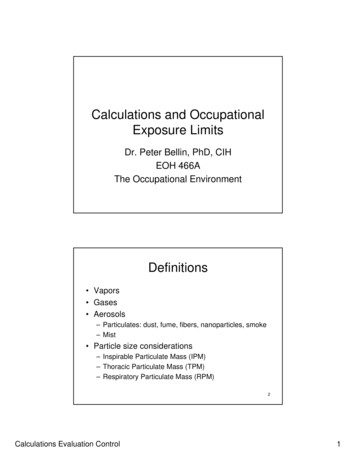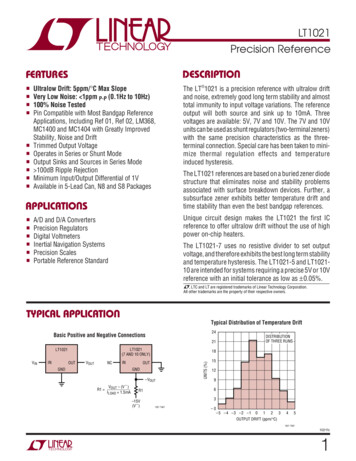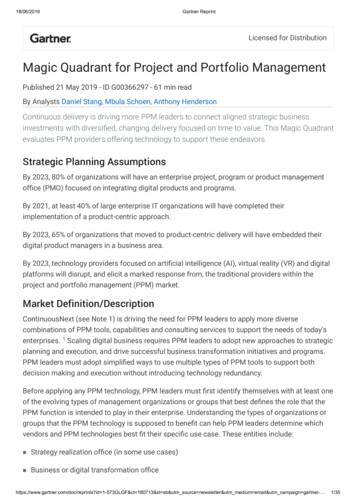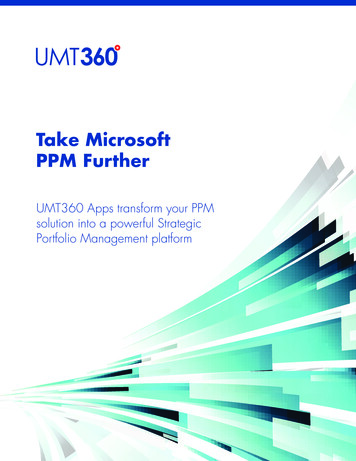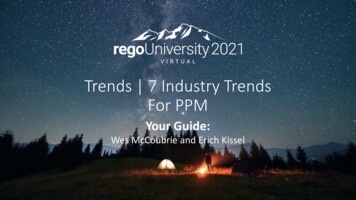
Transcription
Trends 7 Industry TrendsFor PPMYour Guide:Wes McCoubrie and Erich Kissel
Agenda Introduction and OverviewGoing Beyond Strategic AlignmentPivoting QuicklyValue Scrutiny for PPMHybrid Financial ManagementArtificial Intelligence is Getting RealBalanced Ecosystem of ToolsCollaborationLet Rego be your guide.
Wes McCoubrieSr. Solution Architect,Rego ConsultingSenior Solution Architect, with over 15 years of experience inimplementing PPM solutions across varied industries and business units. Inevery engagement, couples systems engineering background with realworld study gained as a past PMO manager to provide tailored solutionsthat are backed by the long-term strategic guidance needed to realize thefull value of PPM. The key mission is to become and remain a trustedadvisor for all clients well beyond any one successful go-live.
Erich KisselSr. Solutions Architect,Rego ConsultingProject Portfolio Management (PPM) thought-leader and systems architect/ group manager who has delivered solutions that put people at the centerof process ecosystems via adoption-centric design, and proven valuedelivery methodologies.This has included the enablement of executive success through customerfacing consulting and internal IT leadership roles, mainly focused on SaaSPPM, Agile (SAFe), ITIL, and Organizational Change Management (OCM)outcomes-based initiatives.Additionally, a contributing author of the book Realize PPM (2020), anactive blogger, professional Twitter account manager and has presented /actively participate in many industry events, including Global PMI, GartnerSummit and Magic Quadrant white papers, etc.
OverviewToday we will discuss:What should I expect to see within my organizationrelated to PM over the next couple of years?How should I prepare my PMs, PMOs, or myself toembrace the new trends within the industry?Tool Kit - what are the top industry trends Rego iscurrently observing within PPM?Let Rego be your guide.
How We Build the List Rego has 600 PPM customers. Our team of experts participate as speakers and attendees within industry conferenceslike PDMA, Gartner, Forrester, PMI, CampIT, and many others. While there, we speakwith many PPM leaders to understand their struggles. We polled our team of 200 PPM experts to ask what they see at their clientsregarding best practices and trends for the future. We distill the results down to 7 key themes. Each year, this set is revisited. New trendsare identified, existing ones are tweaked, and some are removed as having become “oldnews.”
Trend 1:Going Beyond Strategic Alignment
Going Beyond Strategic AlignmentWe learned it again–strategy matters. But how thatstrategy is activated is being forced to change: It’s not good enough to align strategy to execution; it’sbecome imperative to build flexibility into the fabric of thealignment framework. OKRs are more important than ever, with a growing focus onquantification and measurement against expectations (e.g.,baseline, target, actual). As markets shift, frontline workers must be able to adjust,while keeping new OKRs aligned to this more flexibleframework. Technology that supports connecting these dots is becomingan important differentiator for major PPM platforms.
Get On-Track With This TrendClarify Goals: Create a clear strategy. Strategy cannot be implemented if all leaders cannot describe it;employees cannot support a strategic implementation if they do not understand it.Align: Create a flexible framework and ensure your tools allow pivots to stay aligned with that framework.Adjust: Ensure that strategic execution and performance go hand in hand. If performance is lacking, thingsneed to change.Merge Processes: Going beyond traditional strategic alignment doesn’t mean abandoning existingprocesses and procedures altogether. Take stock of what’s working and what isn’t so you can move forwardwith the best of both worlds.
Trend 2:Pivoting Quickly
Pivoting QuicklyWe all know this is important, but what does thatmean? Reprioritize funds: Ability to shift, track and make budgetavailable for new initiatives. Shift products: Reprioritize or add new products for (e.g.,masks or PPE). Financial analysis: Many companies went into businesscontinuity mode and needed to quickly identify discretionaryvs. non-discretionary investments so that they knew wherethey could cut costs. Portfolio scenario planning: This critical capabilityshould have shined in this situation.
Get On-Track With This TrendFacilitate: In the future, the ability to pivot rapidly will be critical. Organizations will need processes and toolsthat facilitate quick analyses and action, while maintaining strategic alignment.Consider a Shift: Think about a shift to a product-management approach, which may enable more planningflexibility. This method can set the groundwork for nimbler operations through trial and error.Understand: Analyze the last year to see where improvements were made and where processes are stilllacking. This analysis may include breaking down each process to adjust it to the way things work today.Evaluate Plans: Assess your business continuity and emergency preparedness plans. If a complete review istoo daunting right now, consider a waved approach that aligns with strategic initiatives.Analyze Goals: Review how well your organization tracked to key business goals as you pivoted this year. Theneed for agility runs from execution to strategy, and top-level business goals must support rather than hinderthese shifts.Synchronize: Ensure that your organization can pivot in synchrony across all areas of work. Agility is onlyeffective if it’s done in unison across the enterprise.
Trend 3:Value Scrutiny for PPM
Value Scrutiny for PPMCOVID has put PPM tools to the test. Those that didn’tdeliver have come under serious scrutiny: Partial use is exposed: If the PPM tool isn’t used for criticaldecision making or if utilization is low, it can be viewed as anunnecessary cost (e.g., companies that are using it just for timeentry). PPM vs. Agile/Work Management: Given the rise of Agileand Work Management tools, it’s become increasingly importantto vet the Portfolio and financial management requirements forthe tool. Reduce implementation and maintenance costs:Implementations are increasingly focusing on an MVP approachwith an emphasis on making the tool easy to administer. Support automation: Support is automated whereverpossible (i.e., integrations), outsourced, or replaced with selfservice functions as best as possible.
Get On-Track With This TrendOptimize Tools: Review tool capabilities and determine if value is being driven from the existing toolset. Ifyou’re using an enterprise PPM tool for time-tracking only, which some are, this year showed that there arebetter ways to use it. Make sure PPM solutions are optimized for more than one thing.Consider Integrations: Determine if there are integrations that can increase the value of your tool andperhaps eliminate technological redundancies in other areas.Automate: Explore automated support or self-service capabilities, where possible. Many PPM solutionsinclude this functionality, which lowers costs and increases the benefit of your tool.Use Metrics: Work management and operational key performance indicators (KPIs) are critical tounderstanding the value of a PPM tool. Identifying and activating these indicators ensures that you invest in theright PPM capabilities and that the organization understands the investment and expected results.Understand Differences: “Value” is relative to each organization and may vary across teams or line ofbusiness. A comprehensive cost-benefit analysis includes a deep understanding of how your PPM solution isused across the enterprise.
Trend 4:Hybrid Financial Management
Hybrid Financial ManagementFinancials are very much front and center (still).Nearly every company has a combination of agileand waterfall projects, however, which makefinancials messy.Financial funding and control processes need to bein place to support products, teams, and individualprojects.Finance needs to get flexible.
Get On-Track With This TrendVisibility: Even in a hybrid methodology environment, decisions are increasingly being made in real-time.Making accurate platform data visible and accessible to managers is key.Flexibility: A hybrid approach to financial management often spurs different perspectives on howfinancial project data is gathered, stored, and analyzed. Each platform has its go-to method, but combinedplatforms calls for creative thinking.Connectivity: Even though work is done on different platforms via different methods, integrating thesystems makes it exponentially easier to gain an accurate financial picture of individual projects andenterprise-level initiatives. You can simultaneously eliminate redundant manual tasks and give managersdeep insights that serve a critical function when looking at projections and possible course corrections.
Trend 5:Artificial Intelligence is Getting Real
Artificial Intelligence is Getting RealAI is surging in the PPM space for the same reasons PPMsoftware was initially developed Increasing overall speed and efficiency by automating projectmanagers’ daily/weekly/yearly tasks. Analyzing data patterns from past projects, AI can automaticallyanticipate if project efforts are veering off track. Using this same data, predictive analytic capabilities are becomingtool differentiators. Especially for cloud-based solutions that haveaccess to a wealth of project data, the ability to predict futureperformance based on the historical data is no longer a nichesoftware offering. Resource management is also one of the more mature andpromising areas, helping PMs quickly staff projects based onavailable resources, as well as flagging optimal staffing patternsbased on project success.
Get On-Track With This TrendGet smart: Educate your team about AI and what it’s capable of bringing to PPM. You’ll be prepared toembrace these innovations as they begin.Seek opportunities: Identify mundane tasks that could potentially be automated and any “what-ifs”that your current strategic and operational paradigms prohibit.Collect data: A machine is only as smart as the data you give it. Create databases with foresight, so themetrics you collect will fuel future strategies.Consolidate: Standardize on a universal system; consolidation leads to a more constructive and usefuldatabase.Get Help: AI is cutting-edge and evolving quickly. Don’t try to tackle its learning curve alone. Instead, seekthe help of experts as you move forward. You can begin by building small automations to remove nonvalue-add tasks and lay the groundwork for the future.
Trend 6:Balanced Ecosystem of Tools
Interconnectivity vs. Single PlatformMarket demand is driving three macro trends in thisarea:1.Platforms continue to expand their offerings through strategicacquisitions and partnerships. Some are pitching the singleplatform approach, while others are building out a connectedportfolio.2.Point solutions continue to proliferate, keeping buyers busystaying on top of options and forcing larger competitors toconstantly evaluate their strategic direction.3.Platforms are increasing their capability for connectivity. Tocounter these threats, they’ve taken a page from early platformpioneers and built out their integration ecosystems.
Get On-Track With This TrendReview: Analyze your digital ecosystem from top to bottom to understand how your tools work together and ifthere is too much overlap or redundancy.Create an Inventory: To determine the current burden and load on your organization, examine your full suiteof tools in relation to the administrative tasks and functions they perform.Strategize: Look at your organizational strategy for interconnectivity from a three-year perspective. Establishclear business goals, plan for identification and alignment of systems, and think ahead to how systemsintegrations will be governed.Look at Needs: Ask around, conduct surveys, and otherwise evaluate current needs of each department.Which tools are wanted? Which are needed? How do these tools fit into current and future strategic plans?Keep Watch: If there is a delay in decision making for whatever reason, see if this delay presents a marketopportunity risk.
FREE Digital Ecosystem AssessmentAn Interconnected Ecosystem is Essential to Drive Digital Transformation.Do you feel you have the right ecosystem components yet lack an interconnected end-to-end solution?Are your applications getting in the way of an optimized business process?Do you need a strategic roadmap and phased execution plan that includes people, process, and tools?Rego's experts will discover opportunities to optimize the value of your digital ecosystem.
Trend 7:Collaboration
Collaboration Collaboration capabilities need to exist at every levelof work. Companies are still experimenting with technologiesthat replace face-to-face meetings and whiteboardsessions. Expect more PPM integrations with the solutions thatbubble to the top of this list (e.g., Teams, Mural).
Get On-Track With This TrendAudit Tools: Conduct an application audit for the most successful collaboration tools thatteams are using and contrast that with unused tools. This includes project and workmanagement solutions, chat applications, document management, documentcollaboration, proofing, and video conferencing. What are teams using to get their jobdone each day?Review Processes: Look at current processes to determine if adjustments or new strategieswill better accommodate more efficient work for a digitally distributed and/or hybridwork structure.Look for Gaps: Investigate the many PPM and Work management integrations to addresstechnology or collaboration gaps (see Trend #6).Consider Integrations: Consider solutions that allow teams to work with only a few toolsefficiently. For example, many tools integrate with Zoom or Teams for schedulingappointments or integrate with SharePoint, Box, or DropBox for access to documentation.Create a Strategy: Start building a long-term, digitally distributed work environmentstrategy.Be Thorough: Ensure that collaboration capabilities exist at every level of work. From chatand video to shared document editing and digital whiteboarding, ensure that teams havethe tools they need to get work done.
Questions?Let Rego be your guide.
Thank You For Attending regoUniversityInstructions for PMI credits Let us know how we can improve!Don’t forget to fill out the class survey.Access your account at pmi.orgClick on CertificationsClick on Maintain My CertificationClick on Visit CCR’s button under the Report PDU’sClick on Report PDU’sClick on Course or TrainingClass Name regoUniversityCourse Number Session NumberDate Started Today’s DateDate Completed Today’s DateHours Completed 1 PDU per hour of class timeTraining classes TechnicalClick on I agree and mWebsitewww.regouniversity.comLet Rego be your guide.
Additionally, a contributing author of the book Realize PPM (2020), an active blogger, professional Twitter account manager and has presented / actively participate in many industry events, including Global PMI, Gartner Summit and Magic Quadrant white papers, etc.

